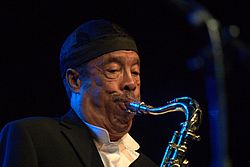Johnny Griffin facts for kids
Quick facts for kids
Johnny Griffin
|
|
|---|---|

Griffin performing in 2007
|
|
| Background information | |
| Birth name | John Arnold Griffin III |
| Born | April 24, 1928 Chicago, Illinois, U.S |
| Died | July 25, 2008 (aged 80) Paris, France |
| Genres | Jazz |
| Occupation(s) | Musician |
| Instruments | Tenor saxophone |
| Years active | 1940s–2008 |
| Labels | Blue Note, Riverside |
| Associated acts | Eddie "Lockjaw" Davis, Thelonious Monk, Kenny Clarke/Francy Boland Big Band |
John Arnold Griffin III (born April 24, 1928 – died July 25, 2008) was an amazing American jazz musician. He played the tenor saxophone. People called him "the Little Giant" because he wasn't very tall, but he played with a lot of power and energy! Johnny Griffin started his music career in the mid-1940s and kept playing right up until he passed away. He was a very important person in a style of jazz called hard bop. Griffin made many recordings as a bandleader. He also played with famous musicians like Thelonious Monk and Art Blakey. Later, he teamed up with another tenor saxophone player, Eddie "Lockjaw" Davis. After moving to Europe in the 1960s, he joined the Kenny Clarke/Francy Boland Big Band. In 1995, he received a special award, an Honorary Doctorate of Music, from Berklee College of Music.
Early Life and Music Career
Johnny Griffin studied music at DuSable High School in Chicago. His teacher was Walter Dyett. He first learned to play the clarinet, then the oboe, and finally the alto saxophone. When he was only 15 years old, still in high school, Griffin was already playing with T-Bone Walker's band.
After graduating from high school, Griffin joined Lionel Hampton's big band. He was still playing the alto saxophone. However, Hampton encouraged him to switch to the tenor saxophone. He played alongside another great musician, Arnett Cobb. Griffin's first recording was with Hampton's band in Los Angeles in 1945, when he was just 17.
By 1947, Griffin and fellow Hampton band member Joe Morris formed their own group. It was a sextet, meaning it had six musicians. He stayed with this group for two years. You can hear his playing on some early rhythm and blues recordings. By 1951, Griffin was playing the baritone saxophone in an R&B band led by Arnett Cobb.
After serving two years in the Army, Griffin returned to Chicago. He quickly became known as one of the best saxophone players in the city. The famous jazz pianist Thelonious Monk was very impressed by Griffin. Monk told Orrin Keepnews of Riverside Records to sign Griffin. But before Riverside could act, Blue Note Records signed him instead.
In 1957, Griffin joined Art Blakey's Jazz Messengers. During this time, he recorded an album with the Messengers and Thelonious Monk. Griffin then took over from John Coltrane in Monk's quartet. You can hear him on Monk's albums Thelonious in Action and Misterioso.
Griffin had a very special way of playing. He had amazing technique and knew a lot of bebop music. He often used parts of classical music and opera in his solos. He was known for his "cutting sessions," which were like musical battles between two musicians. He had these battles with other tenor players in Chicago, like Hank Mobley and Gene Ammons, and also when he was touring. Even though he was short, he was known for being a stylish dresser and a good bandleader.
Griffin led his first Blue Note album, Introducing Johnny Griffin, in 1956. This album also featured Wynton Kelly on piano, Curly Russell on bass, and Max Roach on drums. The recording brought Griffin a lot of praise from music critics.
His 1957 album, A Blowin' Session, featured other jazz legends like John Coltrane and Hank Mobley. He played with Art Blakey's Jazz Messengers for a few months in 1957. He also played in the Thelonious Monk Sextet and Quartet in 1958. During this time, he recorded with Clark Terry on Serenade to a Bus Seat.
Moving to Europe
In 1963, Johnny Griffin moved to France. Later, in 1978, he moved to the Netherlands. He decided to move for personal reasons and to find new musical opportunities. While in Europe, Griffin often played at jazz clubs, like London's Ronnie Scott's. He also became a top choice for American musicians who were touring Europe in the 1960s and 1970s.
In 1965, he recorded albums with the famous guitarist Wes Montgomery. He briefly rejoined Monk's groups in 1967. From 1967 to 1969, he was a member of the Kenny Clarke/Francy Boland Big Band.
Griffin and Eddie "Lockjaw" Davis played together again in 1970. They recorded Tough Tenors Again 'n' Again. They also performed with the Dizzy Gillespie Big 7 at the Montreux Jazz Festival. In the late 1970s, Griffin recorded with Peter Herbolzheimer and His Big Band. He also recorded with the Nat Adderley Quintet in 1978.
In 1978, Griffin and Dexter Gordon returned to the U.S. They performed at the Ann Arbor Blues and Jazz Festival. They then recorded Live at Carnegie Hall.
Johnny Griffin's last concert was in Hyères, France, on July 21, 2008. He passed away on July 25, 2008, at the age of 80, in France.
Discography
Johnny Griffin recorded many albums as a bandleader and also played on albums with many other famous jazz musicians. Some of his notable albums as a leader include Introducing Johnny Griffin (1956), A Blowin' Session (1957), and The Little Giant (1959). He also made several recordings with Eddie "Lockjaw" Davis, including Tough Tenors (1960).
He also played as a sideman (a supporting musician) on albums by artists like Art Blakey, Thelonious Monk, Dizzy Gillespie, and Wes Montgomery.
See also
 In Spanish: Johnny Griffin para niños
In Spanish: Johnny Griffin para niños


